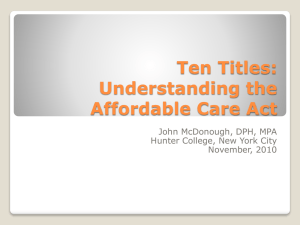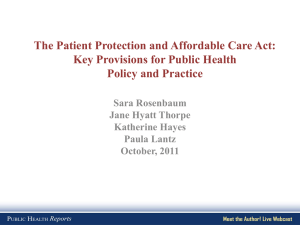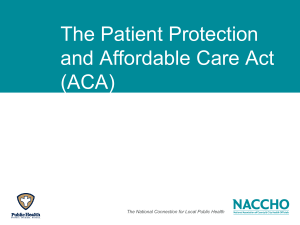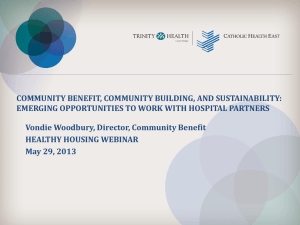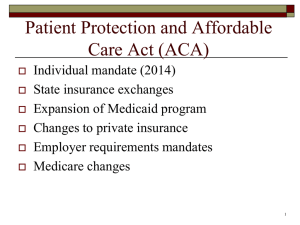AAHAM Presentation - June 2014 - Tom Watson
advertisement
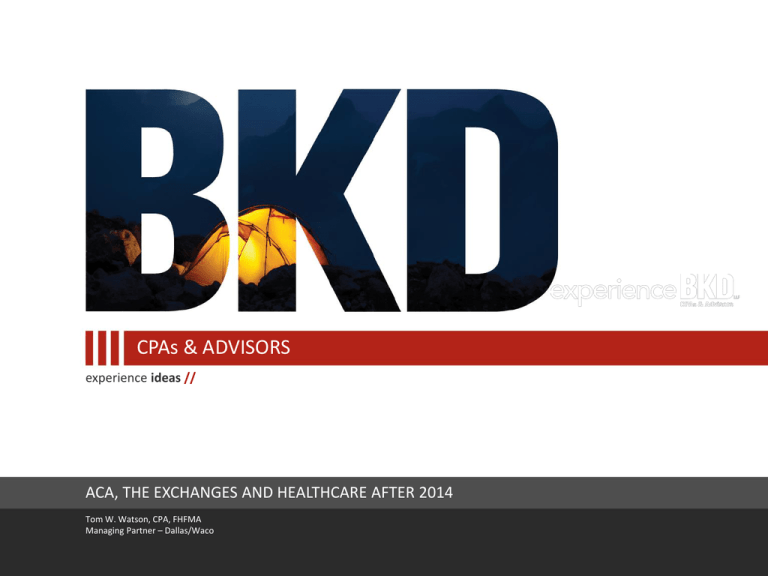
CPAs & ADVISORS experience ideas // ACA, THE EXCHANGES AND HEALTHCARE AFTER 2014 Tom W. Watson, CPA, FHFMA Managing Partner – Dallas/Waco WHY ARE WE HERE? The Uninsured More than 47.9 million uninsured in the U.S. 90% of the uninsured are below 400% of the poverty level More than ¾ of uninsured are in a working family Uninsured individuals have less access to preventive care services The assumption is this leads to higher costs Health care costs have increased substantially, causing employers to drop coverage and individuals to not be able to afford it Many employers are tired of paying the hidden tax needed to subsidize today’s health care system 2 // experience ideas 3 // experience ideas EMPLOYERS PROVIDING HEALTH INSURANCE SOURCE: KAISER FOUNDATION 4 // experience ideas KEY PROVISIONS OF AFFORDABLE CARE ACT Requirement to have insurance coverage Effective January 1, 2014 Penalty for failure to obtain coverage starts that eventually is the greater of $695/year or 2.5% of household income ($2,085). The penalty amounts phase in through 2017, and are insignificant in 2014. Employer requirement to offer coverage 50 or more full-time employees (defined as 30 hours or more per week) Requirement to offer “affordable” coverage Penalty ranges from $2,000/employee if no coverage provided (excluding first 30 employees), or $3,000 per employee receiving premium assistance if coverage is provided but not deemed affordable 5 // experience ideas KEY PROVISIONS OF ACCOUNTABLE CARE ACT Medicaid Expansion Expands Medicaid to cover all individuals with incomes up to 133% of the Federal Poverty Level States are paid 100% (declining to 90% by 2020) of the extra cost of this expansion Supreme Court ruling on ACA made this expansion optional, and 26 states have opted not to expand coverage Premium Credits and Cost-sharing Support Premium credits that limit out-of-pocket costs to between 2% and 9.5% of income for individuals with incomes from 100% to 400% of the FPL Credits are based on the cost of the “second lowest cost silver plan” Cost-sharing credits for families up to 400% of poverty level 6 // experience ideas KEY PROVISIONS OF ACCOUNTABLE CARE ACT Key New Taxes Changes to qualified expenses from HSAs Increase Medicare Part A tax from 1.45% to 2.35% on wages over $250,000/$200,000 for married/single individuals 3.8% tax on unearned (i.e., investment) income Cadillac plan excise tax Fees on pharmaceutical industry Fees on medical device industry Creation of Health Insurance Exchanges Many, many other provisions 7 // experience ideas DELAYED PROVISIONS INCLUDE….. Delay in cuts to Medicare Advantage Plans One year delay in employer reporting IRS rule that allows subsidies to flow through federal exchanges Delay of Small Employer Health Option Employer Mandate delay Self-attestation partially implemented Delay of individual mandate (only one month) Allowed insurance companies to continue to offer “canceled” nonqualified plans Exemption of union plans from reinsurance fee 8 // experience ideas PAYING FOR THE ACA – SPENDING CUTS ($ BILLIONS) 9 // experience ideas PAYING FOR THE ACA – TAX INCREASES ($ BILLIONS) 10 // experience ideas THE ACA INCOME STATEMENT (In billions $) Revenues Less: Program Costs Implementation Costs $ 515 (1,128) (40) (1,168) Operating Loss Add: Cuts in Medicare and other programs (653) 716 $ Source: CBO, Dana Forgione 11 // experience ideas 63 THE IMPACT ON DOCTORS AND HOSPITALS 12 // experience ideas HOSPITALS – DID YOU KNOW?? The average margin for hospitals in 2013 was less than 2.5%? Hospitals on average collect: 2% of amounts billed to uninsured patients 20% or less of amounts billed to Medicaid patients 25 to 30% of amounts billed to Medicare patients Between 30% and 60% of amounts billed to insured patients See the hidden tax here?? In Texas, hospitals average between 15% and 25% of their net revenue as bad debts The average payment increase for hospitals under Medicare and Medicaid has been less than 2% for the last several years, with some years of real reductions in payment rates 13 // experience ideas THE ACA IMPACT ON HOSPITALS In the opening round of the ACA discussions, the enemy was the Insurance Companies Hospitals should be prepared to be the enemies in phase 2 $$$ - Hospitals are the deep pockets when it comes to Medicare cuts The ACA included over $150 billion in cuts for hospitals Implicit promise that coverage will be expanded ACA requires tax exempt hospitals to conduct a Community Health Needs Assessment and to implement a Financial Assistance Policy (FAP) Limitation on “aggressive” collection efforts until proof that FAP does not apply ACA prevents new physician owned hospitals from accepting Medicare/Medicaid patients 14 // experience ideas TRANSITION OF HEALTH CARE PAYMENT METHODS OVER TIME Transition Period (Current) Prospective Payment System (Late 1990s to 2009) Transition period to Prospective Payment System (1990s) Cost Reimbursement (1960s – 1980s) 15 // experience ideas •Payment Demonstration •ACOs •Bundled Payments Value-Based Purchasing System BUNDLED PAYMENTS – NOT JUST MEDICARE! Medicare is piloting bundled payment arrangements, but many private payers are moving full speed ahead Includes facility fees, physician fees, implants, anesthesia, etc. Managing device costs are often the key to success Common procedures Knee and hip replacements Coronary bypass graft Bariatric surgery Diagnostic cardiac catherizations Cataract removal Maternity care 16 // experience ideas MEDICARE 2015 UPDATE AND ACA-DRIVEN IMPACT Hospitals can expect a 1.3% increase in Medicare payments for FY 2015 .4% ACA Productivity Adjustment .2% ACA required reduction .8% documentation and coding adjustment $2 billion in net reduction for 2015 – will be $8 billion next year Medicare DSH cuts mandated by ACA ($49.9 billion over time) Value Based Purchasing reduction will be 1.5% ($1.4 billion in incentives) 778 losers and 630 winners in 2014 (defined as greater than .2% impact) Increase Hospital Readmission Penalty to 3% Increase utilization of hospital acquired condition program Potential changes in Medicare wage index, which will impact DRG payment computation 17 // experience ideas HOW ARE HOSPITAL LEADERS REACTING TO ACA? Generally support the expansion of coverage to reduce bad debts Many are now concerned that the law will not reduce these to the level anticipated Concerned with failure to expand Medicaid Note that many cuts in the original bill assumed that Medicaid would be expanded, offsetting these cuts How will the exchanges really work? Will payment rates be sufficient? Over the long term, revenue is not going up, so costs must go down Continued shift to care in an outpatient setting Focus of many hospital’s capital investments Urgent care centers and “drug-store” clinics How will the federal exchanges impact payer mix? 18 // experience ideas COST SHIFTING– CURRENT EXAMPLE Example Health System 120,000,000 100% 100,000,000 Dollars 80,000,000 Cost Paid 60,000,000 85% Cost incurred 150% Medicare Medicaid Commercial Exchange Self Pay 40,000,000 20,000,000 80% 25% Medicare Medicaid Commercial Exchange Self Pay Total Cost Shift (7,500,000) (2,000,000) 15,000,000 (5,500,000) FEARED PAYER MIX Example Health System 120,000,000 100% 100,000,000 Dollars 80,000,000 Cost Paid 60,000,000 Cost incurred 85% 40,000,000 233%* 20,000,000 100% 80% 25% Medicare Medicaid Commercial Exchange Self Pay Total Medicare Medicaid Commercial Exchange Self Pay Cost Shift (7,500,000) (3,000,000) 13,250,000 (2,750,000) WHY ALL THE CONSOLIDATION IN HEALTHCARE? Significant wave of consolidation in health care industry has five primary drivers: Perceived need for scale in order to survive uncertain environment Hospitals and physicians must work together in an accountable care and medical home model – the same owner makes this easier Squeeze on access to capital for smaller hospitals Private equity view growth in segment with guaranteed cash flows and ability to create economies of scale General fear of the unknown Will it continue? 21 // experience ideas THE ACA’S IMPACT ON PHYSICIANS No change in “doomsday” scenario of Sustainable Growth Rate reduction SGR would reduce payments over 25% for Medicare Continually “punted” to next year Physician practice model is changing The disappearance of independent doctors (nearly 70% employed by hospitals!) Partly due to demographics and expanded regulatory actions Partly due to fear of ACA Physicians are being asked to provide more preventative care Accountable Care Organizations Medical Homes Severe income squeeze in recent years Growth in mid-level providers to prop up incomes (i.e., leverage) 22 // experience ideas 23 // experience ideas Source: www.medscape.com 24 // experience ideas PATIENT ACCESS CONCERNS If the ACA works as intended, many people that previously didn’t have insurance will be covered Social issues aside, there was a self-limiting aspect for access to care when an individual was fully responsible for their physician visit In many cases, the emergency room was used as a primary care office because of this Will our current health system be able to handle a large increase in volume when this restriction on care is removed? 25 // experience ideas THOUGHTS FROM RATING AGENCIES - 2013 Overall weaker performance after three years of stability Balance sheets remain stable due to good investment return Requires the ability to invest in stocks The reappearance of expense growth outpacing revenue growth Looking forward: Anticipate weak financial performance All rating categories will be affected No overriding factors to drive up admissions in 2014/15 Anticipate the transition to value based purchasing will be highly disruptive Rate increases are under pressure (Medicare .7% in 2014!) Effective boards will aggressively attack expenses and CULTURAL change will be required. Benefits will have likely have delayed recognition 26 // experience ideas 27 // experience ideas VOLUME TRENDS PER MOODY'S 28 // experience ideas The Accountable Care Act IMPACT ON BUSINESSES AND INDIVIDUALS 29 // experience ideas EMPLOYER IMPACT The requirement to provide coverage is the most significant impact Most questions remain unanswered. There is anecdotal evidence for yes and no to each of the following questions: Will employers drop coverage and elect to pay the penalty under ACA? How will ACA affect working hours? Will employers work to keep individuals below 30 hours? How will the ACA affect job growth? Will the 50 employee limit stifle expansion? The bigger issues evolve around reporting and compliance with the law Structure of health plans to meet minimum coverage and enrollment standards Reporting coverage to IRS 30 // experience ideas HIGHER TAXES FOR HIGH EARNERS Taxpayer A* Net Investment Income $ 100,000 Wages 300,000 Modified AGI 375,000 Tax on Investment Income (3.8%) 3,800 Tax on Income in Excess of $200,000 6,650 Lesser Amount $ 3,800 Tax on earned income in excess of $200,000 (0.9%) $ 900 Total Additional Medicare Tax $ 4,700 * Taxpayer's filing status is single 31 // experience ideas PRIVATE HEALTH INSURANCE EXCHANGES There are several private health insurance exchanges Allows employers to adopt a “defined contribution” approach to employee health insurance Pros and cons Takes the risk off of the employer, but are employees ready for this choice? Will employees choose the right level of coverage Enhances ability for employees to compare true compensation vs. the hidden compensation of health care Generally more flexible than public exchanges Ability to offer various products (even non-insurance ones) http://www.booz.com/media/file/BoozCo-Emergence-Private-Health-InsuranceExchanges.pdf 32 // experience ideas THE HEALTH INSURANCE PUBLIC EXCHANGES Available to individuals not covered by employee health plans State exchanges vs. federal exchanges Four levels of coverage Bronze (60% of average costs of care) Silver (70% of average costs of care) Gold (80% of average costs of care) Platinum (90% of average costs of care) The average individual market plan for some large carriers is currently 57% , so costs have to be higher, right? The impact on the health care provider marketplace and individual choice Anecdotal evidence says rates paid are slightly less than current rates, but not as low as some feared Increasing use of “narrow networks” to encourage lower rates 33 // experience ideas TEXAS AND THE PUBLIC EXCHANGE Most areas have multiple plans to chose from (38 family plans for Dallas County) Many big insurance players are in the plans: Aetna Cigna Blue Cross Molina Several areas do not have “platinum” plans available Narrow networks are very common 34 // experience ideas EXAMPLE OF RATES AND COVERAGE FOR DALLAS COUNTY Individual/Family Deductible Maximum Out-of-pocket Cost of Primary Care Visit Cost of Specialist Visit Payment for Inpatient Care Coverage of Name Brand Drugs Annual Premium before subsidy Projected Cost of Normal Delivery My Plan $600/$1,800 $2,000/$6,000 $20 $35 Bronze Plan Silver Plan Gold Plan $6,100/$12,200 $3,000/$9,000 $0/$0 $6,350/$12,700 $6,350/$12,700 $5,000/$10,000 $0 $35 $30 $0 $55 $60 80% after $250 coinsurance and 80% after deductible 100% deductible $1,000/day $30 $0 $50 $45 $9,312 $2,000 Note: All amounts assume "in-network" care is provided. 35 // experience ideas $8,424 $6,130 $9,048 $4,050 $11,976 $2,990 EXCHANGE ENROLLMENT THROUGH MARCH 2014 36 // experience ideas PREMIUM ASSISTANCE CREDIT Household Income Relative to Federal Poverty Level* Initial Premium Percentage (1) Final Premium Percentage (1) Up to 133% 133% up to 150% 150% up to 200% 200% up to 250% 250% up to 300% 300% up to 400% 2.00% 3.00% 4.00% 6.30% 8.05% 9.50% 2.00% 4.00% 6.30% 8.05% 9.50% 9.50% * Household incomes above 400% of poverty line not eligible for credit (1) Maximum share of income enrollee will have to pay for coverage FEDERAL POVERTY LEVEL FOR 2013 Individual 100% = $11,490 133% = $15,282 ($7.34/hour) 200% = 22,980 ($11.04/hour) 400% = $45,960 ($22.09/hour) Family of 4 100% = $23,500 133% = $31,322 200% = $47,100 400% = $94,200 A family of 4 at 200% of the poverty level would be responsible for $314/month in premium before a subsidy was received A family o f 4 at 400% of the poverty level would have to pay up to $745/month in premium before a subsidy was received 38 // experience ideas MEDICAID EXPANSION 26 states, including Texas, did not expand Medicaid Why it matters Medicaid only covers specified categories of individuals I.e., no coverage for childless adults in poverty ACA assumed that all individuals under 138% of poverty would qualify for Medicaid No subsidies are provided for individuals with less than 100% of FPL Individuals between 100% and 138% can receive premium assistance that would require them to pay about $500/year toward health care coverage Texas has about $6.1 million uninsured Failure to expand Medicaid leaves about 1,000,000 individuals without coverage 39 // experience ideas BREAKING THE LOG JAM Would Texas consider the “Arkansas” option? The Arkansas option: Doesn’t technically expand Medicaid Uses the additional funds from the ACA to buy private insurance for newly eligible individuals up to 138% of the poverty level Those that would have qualified for Medicaid previously still use that program No premium for enrollees Enrollment would be in “silver” plans State pays premiums directly to insurance companies Must address the co-pay required by many insurance companies Requires some cost sharing for beneficiaries over 100% of FPL Potential hidden cost of the program most often targeted by critics Cost is $188mm in CY 2014 for 200,000 enrollees (multiply by 6x to 8x for Texas?) 40 // experience ideas THE TEXAS MEDICAID WAIVER Waiver Basics Uncompensated Care reimbursement Delivery System Reform Improvement Program (DSRIP) payments 5 year program with billions of dollars of revenue at stake Replaces UPL program We are now entering DY3 Implementation has been somewhat rocky, with several payment delays Cash is running, on average, six months behind schedule Some providers have trouble finding IGT funds The future of the program Big winners are governmental hospitals, especially large districts A statewide fight is brewing on how future Waiver and DSH funds should be allocated 41 // experience ideas OTHER TEXAS TRENDS AND DEVELOPMENTS Provider taxes and assessments? Medicaid DSH battles Burden alleviation fatigue Physician hospitals and working around the ACA M&A Activity Hospitals buying hospitals Preparing for bundled payments Private equity 42 // experience ideas The Accountable Care Act PREDICTIONS AND KEY TRENDS 43 // experience ideas EMPLOYERS ROLE IN HEALTH CARE 44 // experience ideas PATIENTS AS CONSUMERS 45 // experience ideas CONSUMER SURVEYS OFFER INSIGHT Nearly 57% of employees would like to customize their own health plan 70% would like to see hospital and physician prices “on-line,” including what the insurance company will pay to these groups 62% of employees would be willing to use self-monitoring devices to manage their health Nearly two-thirds would like to use video conferencing or other nonpersonal means for follow-up visits There is a growing willingness for technology to replace direct physician access Look for presentations by Eric Topol on-line or read his book the “The Creative Destruction of Medicine” 46 // experience ideas CONCIERGE MEDICINE 47 // experience ideas POPULATION HEALTH MANAGEMENT 48 // experience ideas MULTIPLE EXAMPLES OF “MANAGEMENT” IN INSURED POPULATION Narrow steerage of certain patients to “centers of excellence” Cardiovascular care Orthopedic and rehabilitative services Exclusion of high-cost providers from networks on a service line basis Incentives for employees to choose lower cost options in the marketplace Medical tourism 49 // experience ideas WE HAVE SEEN THIS BEFORE… THEN NOW - Balanced Budget - Healthcare Reform - HMOs (Health Maintenance Organizations) - ACOs (Accountable Care Organizations) - Capitation - Bundling - Sustainable Growth Rates (SGR) - SGR? MEDICAL HOMES In general, a Medical Home is a group of providers that coordinate care for individual patients Comprehensive Care Patient-centered care Coordinated Care Accessible Services Quality and Safety Growth from 0 to 29,000 providers and 6,000 sites since 2008 Impact on costs and quality has been debatable Several examples of better outcomes and lower costs for patients with chronic health conditions Patient cooperation has been a key concern 51 // experience ideas ACCOUNTABLE CARE ORGANIZATIONS What is an ACO? Accountable Care Organizations (ACOs) are groups of doctors, hospitals, and other health care providers, who come together voluntarily to give coordinated high quality care to their Medicare patients. What is goal of an ACO? The goal of coordinated care is to ensure that patients, especially the chronically ill, get the right care at the right time, while avoiding unnecessary duplication of services and preventing medical errors. What happens if an ACO works? When an ACO succeeds both in both delivering high-quality care and spending health care dollars more wisely, it will share in the savings it achieves for the Medicare program 52 // experience ideas 53 GEISINGER HEALTH SYSTEM ACUTE ADMISSIONS DECLINED (MEASURED AS ACUTE ADMITS/1,000, ACUITY ADJUSTED) Source: Ronald A. Paulus, MD, EVP, Clinical Operations, Geisinger Health 54 // experience ideas INDEPENDENT PAYMENT ADVISORY BOARD 55 // experience ideas FINANCIAL EFFECT OF AGING US POPULATION ON HEALTHCARE COSTS Healthcare Costs by Age Source: Fischbeck, Paul. “US-Europe Comparisons of Health Risk for Specific Gender-Age Groups.” Carnegie Mellon University; September, 2009. U.S. is spending much more for older ages THANK YOU FOR MORE INFORMATION // For a complete list of our offices and subsidiaries, visit bkd.com or contact: Tom W. Watson, CPA, FHFMA// Managing Partner twatson@bkd.com // 972.392.7400


